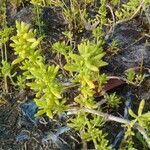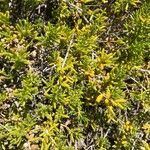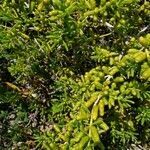Prostrate, glabrous, dioecious shrubs, the bark soon flaking off; rooting at the nodes, the branching alternate, the leafy short shoots with elevated, faintly 2-lobed leaf scars and immediately above them minute bud scars. Leaves suc-culent, linear, terete or approximately 3-4-angled in cross-section, to 2 cm long, apically acute or mucronate, basally clasping and drying with a basal, reflexed appendage; stipules inconspicuous, caducous. Inflorescences axillary, shortly pedunculate, congested, indeterminate catkins or syncarps subtended by an op-posite pair of scalelike bracts, not enlarging or enlongating much with age. Male inflorescence with 10-30 pairs of decussate flowers, each surrounded by a cam-panulate, 2-lobed perianth which is appendaged on the dorsal side just below the rim to give the appearance of imbricate bracts, the flower consisting of 4 stamens alternating with 4 minute spatulate, petaloid staminodes, the anthers ovoid, dorsi-fixed, versatile, introrse, dehiscing longitudinally, exserted on stout, glabrous fila-ments, the gynoecium wanting; female inflorescence an irregularly ellipsoidal syncarp to 5 mm long of 4-8 fused pistils which bear persistent, scalelike, 1 mm wide tepals near their apices, the style umbonate, the 2 stigmas capitate and connivent, the ovary with 4 unequal locules and one basal ovule in each locule. Fruits drupaceous syncarps with 1-several pyrenes, the outer tissue fleshy or leathery, the endocarp woody; seeds oblong, nearly straight.
More
Plants usually less than 1 m. Main stems 2-4 cm diam. at base; branches rooting at nodes and tips. Leaf blades 5-20 × 2-3 mm, apex rounded to acuminate, adaxial surface flattened. Spikes 6 × 4 mm, flowers inconspicuous. Staminate flowers: tepals spatulate or tapered, 3 × 3 mm; filaments 2 mm; anthers 0.7 mm. Pistillate flowers connate at maturity, subsessile, 6 × 4 mm. Syncarps green, 10 × 6-7 mm, spongy. Seeds 3 × 1 mm. 2n = 22.
Dioecious. Flowers and fruits in spikes, in the axil of bracts and inflorescences axillary. Spathella of the ♂ flowers consisting of one membranous structure. Tepals of the ♂ flowers abruptly narrowed below the middle. Connective of anthers not produced. Fruits united into a connate, spikelike whole.
A small shrub. It is slightly woody at the base. The stems are trailing. It forms roots at the nodes. The leaves are simple, narrow and opposite. They are fleshy. Male and female flowers are on separate plants. The flowers are small and in cone like groups in the axils of leaves.



